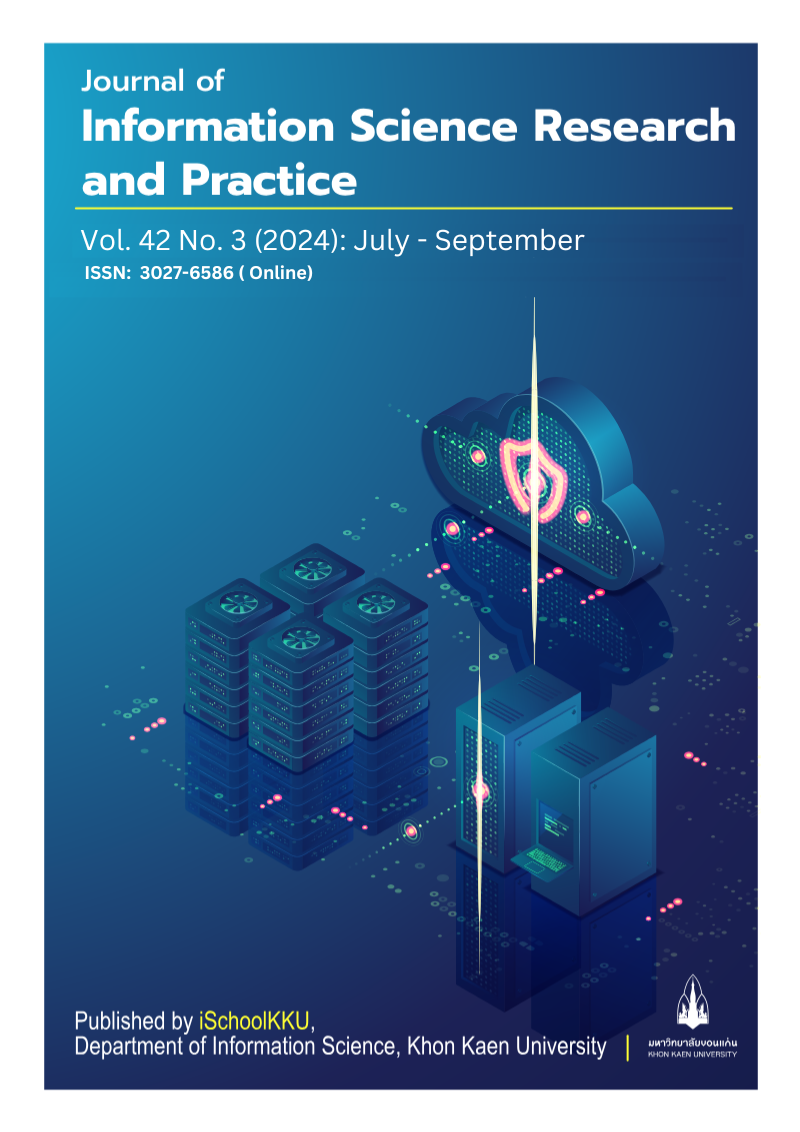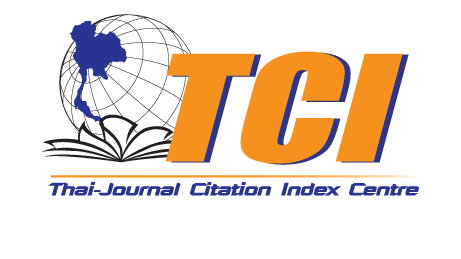การศึกษาความสัมพันธ์เชิงพื้นที่ของอาชญากรรมในประเทศไทย
DOI:
https://doi.org/10.14456/jiskku.2024.21คำสำคัญ:
อาชญากรรม, สถิติเชิงพื้นที่ , การวิเคราะห์เชิงพื้นที่ , ฮอตสปอต, ระบบสารสนเทศภูมิศาสตร์ , ประเทศไทยบทคัดย่อ
วัตถุประสงค์: เพื่อศึกษาอัตราการเกิดอาชญากรรมที่มีความผิดเกี่ยวกับชีวิต ร่างกายและเพศของประเทศไทย และวิเคราะห์รูปแบบของความสัมพันธ์เชิงพื้นที่ระหว่างการเกิดเหตุอาชญากรรมในความผิดที่เกี่ยวกับชีวิต ร่างกาย และเพศ ตั้งแต่ปี พ.ศ. 2560-2564
วิธีการศึกษา: เก็บรวบรวมข้อมูลทุตติยภูมิในการเกิดอาชญากรรมเพื่อศึกษารูปแบบของการเกิดอาชญากรรมที่เกิดขึ้นในประเทศไทยในความผิดเกี่ยวกับชีวิต ร่างกาย และเพศ ด้วยโปรแกรมสารสนเทศภูมิศาสตร์และทำการวิเคราะห์เชิงสถิติภูมิศาสตร์ด้วย Moran’s I และ Getis-Ord Gi* ในการประเมินหาพื้นที่เสี่ยงในการเกิดอาชญากรรมของประเทศไทย
ข้อค้นพบ: อาชญากรรมที่เกี่ยวกับชีวิต ร่างกายและเพศ ของประเทศไทยระหว่างปี พ.ศ. 2560 – 2564 มีแนวโน้มที่ลดลงตลอดระยะเวลา 5 ปี หากแต่ถึงในปี พ.ศ. 2564 การเกิดอาชญากรรมเชิงพื้นที่มีรูปแบบการเกิดแบบเกาะกลุ่มสูงในพื้นที่ภาคกลางและภาคใต้ โดยประเภทอาชญากรรมที่พบมากที่สุดคือการทำร้ายร่างกายผู้อื่น และพบน้อยที่สุดคือ ประเภทการทำร้ายผู้อื่นถึงแก่ความตาย
การประยุกต์ใช้จากการศึกษานี้: การศึกษานี้เป็นแนวทางในการศึกษาหาการป้องกันและหาแนวทางในการแก้ปัญหาการเกิดเหตุอาชญากรรมที่เกี่ยวกับชีวิต ร่างกายและเพศในพื้นที่ต่าง ๆของประเทศไทยและเพื่อการศึกษาวิจัยต่อในเรื่องของปัจจัยในการเกิดอาชญากรรมที่เกี่ยวกับชีวิต ร่างกาย และเพศ
Downloads
เอกสารอ้างอิง
Achu, A., & Rose, R. (2016). GIS analysis of crime incidence and spatial variation in Thiruvananthapuram city. International Journal of Remote Sensing Applications, 6(0), 1. https://doi.org/10.14355/ijrsa.2016.06.001
Bank of Thailand. (2023). Forecast summary as of 12 June 2024. (In Thai). Retrieved from https://www.bot.or.th/th/thai-economy/economic-outlook.html
Bunnarong, B. (2019). An analysis of fundamental offence of bodily harm. Master thesis, Chulalongkorn University.
Chaemsuwanwong, A. (2003). Forensic science 1 for crime investigation. (In Thai). (Vol. 4). Bangkok: TCG printing.
Chainey, S., & Ratcliffe, J. (2013). GIS and crime mapping. John Wiley & Sons.
Geoinformatics Research Center for Thailand. Learning GIS. Retrieved from https://www.gisthai.org/about-gis/gis.html
Getis, A., & Ord, J. K. (1992). The analysis of spatial association by use of distance statistics. Geographical Analysis, 24(3), 189-206. https://doi.org/10.1111/j.1538-4632.1992.tb00261.x
John, M., Goodchild, M. F., & Longley, P. (2007). Geospatial analysis : a comprehensive guide to principles, techniques and software tools. Leicester, U.K.: Matador.
Mitchell, A., & Griffin, L. S. (2020). The Esri Guide to GIS Analysis, Volume 2. ESRI Press.
Humanitarian Data Exchange. (2022). Thailand - subnational administrative boundaries. Retrieved from https://data.humdata.org/dataset/cod-ab-tha
Jonathan, O. E., Olusola, A. J., Bernadin, T. C. A., & Inoussa, T. M. (2021). Impacts of crime on socio-economic development. Mediterranean Journal of Social Sciences, 12(5), 71. https://doi.org/10.36941/mjss-2021-0045
Luenam, A., & Puttanapong, N. (2019). Spatial and statistical analysis of leptospirosis In Thailand from 2013 to 2015. Geospatial Health, 14(1). https://doi.org/10.4081/gh.2019.739
Montien-art, S., & Hemwan, P. (2020). Crime predictive model in chang phueak police station neighborhood, Chiang Mai province. Defence Technology Academic Journal, 2(4), 32-41.
National Statistical Office. (2021a). Atchayakam læ khwamphit thi to ong rap thot thang aya [Crimes and offenses punishable by criminal penalties]. (In Thai). Retrieved from http://statbbi.nso.go.th/staticreport/page/sector/th/09.aspx
National Statistical Office. (2021b). Sathiti khadi aya praphet khwamphit kieokap chiwit rangkai læ phet chamnek tam praphet khwamphit yek tam changwat pi songphanharoihoksip - songphanharoihoksipsi [Statistics on criminal cases for crimes related to life, body, and sex, classified by type of offense by province, 2017 - 2021]. (In Thai). Retrieved from http://statbbi.nso.go.th/staticreport/page/sector/th/09.aspx
Niti Thammalai Institute. (2017). Laksana kao khwamphit kieokap phet [Section 9: Sexual Offences]. (In Thai). Retrieved from https://www.drthawip.com/criminalcode/1-40
Office of Justice Affairs. (2022). Updating Thai Criminal Justice 2022. Bangkok: Office of Justice Affairs.
Raksakitkosol, N. (2020). Guidelines for the prevention and suppression of crime For solving social problems. Journal of Roi Kaensarn Academi, 5(1), 1-16.
Rattananvorasawet, P. (2020). Analysis of crime risk areas with Geographic Information System. Chandrakasem Rajabhat University Journal of Graduate School, 15.
Rayejian Asli, M. (2013). Introducing general theory of victimology in criminal sciences. The International Journal of Humanities, 20(3), 53-79.
Registration Management Office. (2022). Sathiti prachakon thangkan thabian ratsadon [Official population statistics from the civil registration]. (In Thai). Retrieved from https://stat.bora.dopa.go.th/stat/statnew/statMONTH/statmonth/#/displayData
Ristea, A., & Leitner, M. (2020). Urban crime mapping and analysis using GIS. ISPRS International Journal of Geo-Information, 9(9), 511. https://doi.org/10.3390/ijgi9090511
Ruankham, W., Nugprachaya, O., & Daoming, W. (2020). Does the sectoral economic growth lower the poverty incidence: additional evidence from Thailand. Suthiparithat Journal, 34(112), 39-60.
Seema, S. (2020). Botbat nitiwitthayasat kap krabuankan yuttham [The role of forensic science in the justice process]. (In Thai). Retrieved from https://library.parliament.go.th/th/radioscript/bthbathnitiwithyasastrkabkrabwnkaryutithrrm
Semprevivo, L. K., & Hawdon, J. (2021). Research on victimization and victimology. The Encyclopedia of Research Methods in Criminology and Criminal Justice, 2, 732-737.







